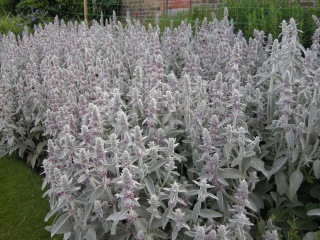Position: Full sun to partial shade
Soil: Moist, well drained
Flowering period: Early summer
Eventual Height: 45cm
Eventual Spread: 60cm
Hardiness: 4a, 4b, 5a, 5b, 6a, 6b, 7a, 7b, 8a, 8b, 9a, 9b, 10a, 10b
Family: Lamiaceae
Stachys byzantina is a perennial with a dense mat forming habit. Its grey/ green leaves are thick/ fleshy, oblong/ elliptic or lance shaped, up to 12cm long and 4cm broad. Its leaves appear in rosettes and have a wooly/ velvet covering. Its purple flowers appear on interrupted spikes on erect stems.
Stachys byzantina, commonly known as Lambs Ear, is native to Turkey, Armenia, and Iran. It is now widely grown in children’s gardens for its soft leaves giving tactile interaction. In Brazil it is grown as an edible herb. RHS’ Tijana Blanusa has discovered that it can greatly lower the surrounding air temperature and is now being used in green roofs to reduce the ‘urban heat island effect’. There is also a variety of this plant called Stachys byzantina ‘Silver Carpet’ which is the same as the species but does not produce the flower spikes and forms an even ground cover.
The etymological root of the binomial name Stachys is derived from the Greek staxus, meaning ‘ear of corn’ or ‘a spike’. Byzantina is derived from the Latin meaning ‘from Byzantium’, the city now known as Istanbul.
Stachys byzantina is useful to the landscape architect as a ground cover plant forming a dense mat. It is useful when designing for children areas, as it is non-toxic and can encourage interaction with the environment. In most temperate climates it will bear leaves all year round and flower from early summer to late autumn. Once established this plant is drought tolerant.
Ecologically, Stachys byzantina this plant will attract pollinating insects with its nectar and pollen.
Stachys byzantina prefers moist, well-drained soils. It tolerates most pH of soil.
Stachys byzantina requires little to no maintenance. Large clumps may be divided in spring. Flower spikes can be removed once flowering is complete to keep a tidy appearance.








Leave a comment